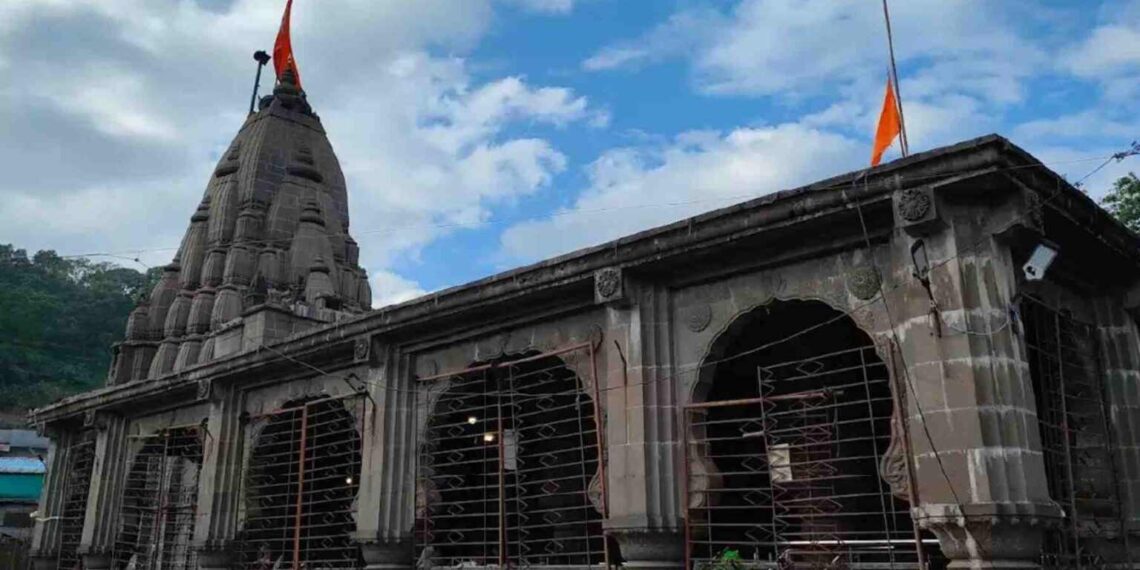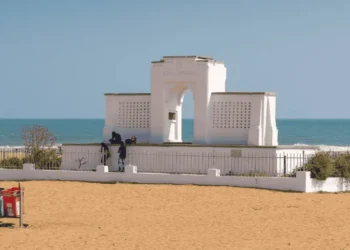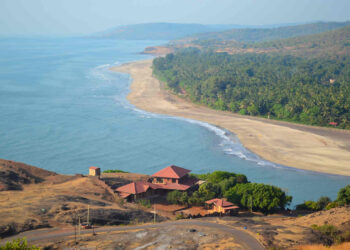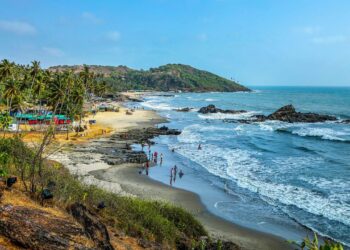Bhimashankar Temple in Pune district, dedicated to Lord Shiva as one of the twelve Jyotirlingas, is a revered place of worship. Set on a rocky hill in the Sahyadri mountains, about 110 km from Pune, its cave-like sanctum(garbagriha), stone carvings, and holy presence draw devotees and pilgrims from all over India.
Mythological Importance
The Bhimashankar Temple carries old legends. One story tells of a demon named Bhima, son of Kumbhakarna, who troubled sages on this hill. Lord Shiva appeared as a Jyotirlinga, slaying Bhima to save his devotees, earning the name Bhimashankar. Another tale says the Bhima River nearby began when Shiva’s sweat fell during the battle. Local belief holds that the hill’s caves have divine power, granting courage and protection. This makes the temple a key Shiva shrine, tied to Vishnu’s protective grace.
Historical Overview
The temple began in the 13th century, under the Yadava dynasty, though some say worship started earlier. The Sahyadri hills, 110 km from Pune, were a holy spot, as old records show. A stone writing from 1250 CE near the hill marks a sacred lingam, but the temple grew with Yadava kings. In the 14th century, Chalukya rulers added halls, as carvings show. The 1600s saw local chiefs build stone steps, making it a busy pilgrimage place. In the 1800s, Maratha rulers kept it safe, and prayers continued, Pune logs note. After 1947, Maharashtra’s leaders took over, and the Endowments Department now runs it. From 2010 to 2018, major repairs added new paths while keeping the old cave sanctum. Marathi songs by saints like Tukaram, who sang of Shiva, carried its name far. Today, it stands as a sign of strong faith, calling thousands to Pune’s hill.
Temple Structure and Design
The Bhimashankar Temple, covering 2 acres, blends Nagara and Hemadpanthi styles, rooted in the hill’s rugged charm. Upon entering the temple through the Mukhya Dwar (main gate), devotees are guided through multiple queues designed for their convenience. The journey begins with a striking white marble statue of Nandi, the sacred bull and vehicle of Lord Shiva, facing the Shiva Linga. It is believed that if one whispers their wishes into Nandi’s ear, he will convey them to Lord Shiva. Within the temple complex is the sacred Bhima Tirtha, a pond believed to be blessed by Shiva’s divine power. The temple is not only an architectural marvel but also a place rich in mythology, where legends like Bhima slaying a demon and Sage Kaushika’s penance add to its sacredness. Devotees flock to the temple to seek blessings, pray at the powerful Shiva Linga, and experience the deep spiritual atmosphere that has been cherished for centuries.
The spire, rebuilt in 1750, rises high with stone carvings of Shiva’s trident, Nandi with a bell, and sages praying, painted in cream and red. A stone door with lotus patterns leads to the cave sanctum, where the Shiva lingam, 3 feet tall, stands under a plain vimana, its stepped roof showing purity. The sanctum’s rock walls, worn by time, hold faint Yadava etchings of Shiva’s fight with Bhima, lit by oil lamps. Small shrines for Parvati, Hanuman, and Kartikeya are scattered on the hill, carved from local granite with open stone covers. The Parvati shrine, from 1300 CE, shows her with lotuses, granting love. The Hanuman shrine, by the steps, depicts him kneeling with a mace, carved in devotion. The Kartikeya shrine, facing Shiva, shows him with a peacock, calling for valor. These shrines, though small, join the temple’s worship, offering paths to faith.
Perched on a Sahyadri hill, the temple is reached by 200 stone steps from Khed village, worn by pilgrims over centuries. The steps pass small caves with old Shiva carvings, some hidden in rocks, others open to the sky. The hilltop courtyard, paved with rough granite, feels holy, shaded by neem and peepal trees. A stone tank, fed by a hill spring, is used for ritual baths, its edges carved with fish shapes, a Maratha touch. The temple’s low walls, made of plain stone, have niches for Naga figures, said to guard the grounds. Carvings on pillars and walls tell Shiva’s stories—his battle with Bhima, his calm meditative form, and his bond with Parvati—etched to guide devotees. The 2018 repairs added strong paths but kept the hill’s wild, sacred feel, making it a quiet place for prayer.
Rituals and Festivals
The temple holds festivals in its full capacity. Mahashivratri, in February or March, is the biggest, honoring Shiva with Rudra Abhishekam and lamp processions. Shravan Maas, in July or August, has Jal Abhishekam with Bhima River water for purity. Deepavali, in October or November, sees lamp-lighting by the caves. Daily worship includes Suprabhata Seva (morning prayers), Archana (offerings), and Deeparadhana (lamp ritual). Services like Laghu Rudra and Shiva Homam can be booked at the temple office. A prasad stall gives free jaggery sweets to devotees. Bilva Archana, offering bilva leaves on Mondays, is for peace and strength.
How to Get There:
Air: Pune’s International Airport, 120 km away, is nearest. Taxis take 3 hours, costing 2000-3000 rupees.
Train: Pune Railway Station, 100 km away, links to Mumbai (3 hours) and Nashik (4 hours). Autos to the temple cost 400-500 rupees.
Road: Bhimashankar is 110 km from Pune. Buses from Pune’s Shivajinagar Bus Stand (3 hours) stop at Khed village, 5 km away. Autos cost 50-100 rupees.
Places to Stay: Khed has guesthouses like Bhimashankar Guest House (500-1000 rupees). Pune, 110 km away, has hotels like Hotel Orchid (2000-4000 rupees). Stalls by the temple sell idli, vada, and tea.
Best Time to Visit: October to March has cool weather, 20-30°C. Weekdays are calm. Mahashivratri brings crowds, so book early.
Nearby Attractions: Hanuman Lake, 5 km away, offers scenic views. Shivneri Fort, 50 km away, is Shivaji’s birthplace. Lenyadri’s Ashtavinayak Temple, 60 km away, is a Ganesha shrine.











